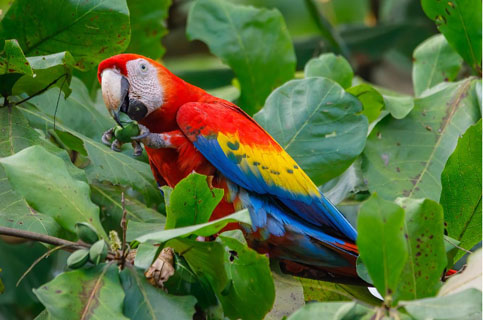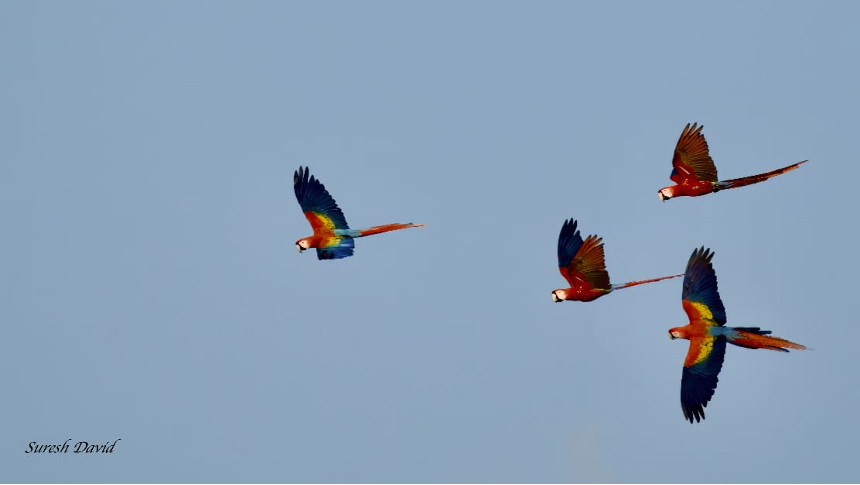Macaws are the largest birds in the Parrot Family and definitely one of the most desirable species to see and photograph on any birding or photography adventure.
There are about 400 species of parrots in the world, and 17 species of Macaws. Macaws are some of the longest living birds in the world. They have been known to live 80 -90 years. These birds are highly gregarious. They mate for life and stay with their chicks for 10-12 years.
You’ll usually see Macaws in their family groups, Mom, Dad, and Chick making their way along the coast, looking for food or a sunny spot to preen.
Costa Rica is lucky to have two species residing within its small borders. We have the Scarlet Macaw and the Great Green Macaws in Costa Rica.
Macaws are what is known as “New World Parrots” meaning they are only found in the Americas.
Characteristics of Macaws include wildly vibrant feathers in greens, blues, yellows, and reds, long tail feathers, larger beaks, and an interesting Light colored medial (facial patch) that looks like skin. Macaws are quite vocal as well.
Guests will usually hear them before they see them. Their tell-tale Squawk can be heard from far away, announcing their arrival. Point your cameras and binoculars to the treetops and you’ll be sure to get a great look at these fabulous birds.
In this guide, we’ll look at the best locations to discover both species of Macaws in Costa Rica.
 |
 |
Photos by Karl Krueger
SCARLET MACAW (Ara macao)
The Scarlet Macaw, sometimes called the flying rainbow, once inhabited 85% of Costa Rica’s territory. Today there are only two populations left but with intense determination from scientists and environmentalists, the Macaw population is rebounding. Thanks to efforts to preserve forest, educate people about the horror of poaching, and create breeding and reintroduction programs, the Scarlet Macaw population is growing. In 1994 it was thought there were only about 400 Scarlet Macaws left in the country, in 2023 that number increased to about 1600 individuals.
The Scarlet Macaw, with its fantastic red, yellow, and blue plumage, is perhaps the most iconic of all macaw species. In Costa Rica, these magnificent birds can be found in several key locations. We’ll look at each spot and recommend accommodations in each area too.
1. Corcovado National Park

Located on the Osa Peninsula in southwestern Costa Rica, Corcovado National Park is renowned for its biodiversity. Corcovado is home to the largest population of Scarlet Macaws in Meso
America. The population is thought to be about 1100 individuals. Birders, Nature Lovers, and Photographers trek to this remote part of Costa Rica for a chance to catch the Scarlet Macaw happily feeding on the “Almendro de Playa” trees. The birds love the nut of this tree that resembles an almond. Here in the dense rainforests and along unspoiled beaches, lucky guests may view flocks of Scarlet Macaws flying overhead or feeding on the fruiting trees. Whether visiting the National Park or staying in a nearby birding lodge, the Osa Peninsula is a very reliable location for viewing the Scarlet Macaw.
Where to stay:
Corcovado Wilderness Lodge
This lodge borders Corcovado National Park. It is unrivaled when it comes to birding and wildlife viewing. Not only do guests have excellent access to the park, but the trails and gardens around the lodge are exceptional. Be sure to go to the Rancho each evening for a cold drink and to watch the Scarlet Macaws returning to the forest to roost.
2. Carara National Park
Located on the Central Pacific Coast, just 90 minutes from San Jose is Carara National Park.
This is another hotspot for Scarlet Macaws. This Central Pacific area is home to the second largest population of Macaws at about 400 individuals. The very interesting transitional forest draws residents from two ecosystems, the dry tropical forest of the north and the tropical rainforest from the south. This life zone is rich with food sources for the Macaws and this forest was the cornerstone of the rehabilitation program for the species.
The “Almendro de Playa” tree populates the Central Pacific coast, providing a great food source and the park provides access to plentiful seeds, nuts and dates, all things that the Macaws love. Visits to the park entrance, early morning and late afternoon will almost always favor guests with excellent looks of the Scarlet Macaw.
Carara National Park is also outstanding for other birds and animals. Visitors can walk or hike along well-maintained trails.
Where to stay:
Cerro Lodge
This simple birding lodge is well known for having Macaws visit its viewing deck. It’s a favorite for photographers.
Tarcoles Birding Hotel
A small rustic hotel with fantastic views and great birding. The grounds provide a great opportunity for enjoying the Macaws and many other bird species.
Nativa Reserve
This small private condominium has beautiful views, lovely accommodations, and fantastic access to viewing the Scarlet Macaw. It’s best to stay here if your trip includes a private guide as there are no restaurants on site, but if you can stay on this property, you’ll enjoy the accommodations and the birds.
 |
 |
Photos by Karl Krueger
3. Other Locations
With continued successful breeding and reintroduction programs, the Scarlet Macaw is “filling the gaps” from the Central Pacific to the Southern Pacific.
Ten years ago guests would never see the Scarlet Macaw in the popular beach town of Manuel Antonio, and now these lovely birds are often seen in the trees around the National Park (Manuel Antonio).
As populations grow and become more successful, Scarlet is even making its way north to the Punta Islita area and Curu (on the Nicoya Peninsula) and some individuals have been seen on the far northern border in Cano Negro.
These sightings suggest that the Scarlet Macaw will crossover to the Caribbean side of Costa Rica too.
 Photo by Karl Krueger
Photo by Karl Krueger
GREAT GREEN MACAW (Ara ambiguus)
The Great Green Macaw is certainly the most colorful and impressive bird on the Caribbean side of Costa Rica. The colors are magnificent, bright green, turquoise blue, brilliant reds and a gleaming black beak. This species was once widespread throughout Central America but loss of habitat dramatically affected food sources and the population dwindled.
The Great Green Macaw is still on the critically endangered list today. Recent censuses conclude there are around 550 individuals in Costa Rica. That is up from 330 individuals accounted for in 2020.
The Great Green Macaw is very unique in that it has a very specific food source. Their main diet relies on a hard shell nut from the Dipteryx Panamensis tree. Unfortunately, this is a very expensive hardwood tree, and these trees were cut down in huge numbers, decimating the food source for the Great Green Macaw. In the late 1990s, the Costa Rica government finally outlawed the cutting of this tree and the effort to save the Great Green Macaw began. The population was critically endangered with under 100 individual birds. Today, we believe there are about 550 individuals.
It’s important to know that Macaws only lay eggs every 2-4 years, and the parents will only raise one chick. Even if they lay two eggs, they will only care for one chick. Repopulation is a long process. Fortunately, efforts to protect and conserve this stunning bird are working and in several locations in Costa Rica visitors have excellent chances of seeing and photographing the Great Green Macaw.
1. Tortuguero National Park
Tortuguero National Park, often called “The Little Amazon” is located on the northern Caribbean coast of Costa Rica. This remote area is a prime habitat for Great Green Macaws. It’s a unique area with no roads, just a network of canals, mangrove forest, marshes, and lowland rainforest. This area provides essential resources for the Great Green Macaw including the food and nesting sites they need.
Guests can explore the canals by boat, kayaks, or canoes, and many lodges also offer forest trails. It’s a special experience to be on the canals early in the morning, with only the sound of the frogs and birds around you, then out of nowhere the distinct squawk of the Great Green Macaws. With a great flash of green and blue you can enjoy the spectacle and the constant chatter between the lovely little family. It’s truly something to behold.
 Photo by Karl Krueger
Photo by Karl Krueger
Where to Stay:
The lodges in Tortuguero are very similar. There is one luxury lodge, Manatus, and the others are rustic lodges set amidst the rainforest and canals. Our favorites are Evergreen Lodge and Aninga Lodge.
2. Sarapiqui
Sarapiqui is an interesting location in the Caribbean Lowlands of Costa Rica. It’s most famous for being the site of La Selva Biological Station. La Selva is a renowned research center and an ecotourism and birding “must visit” location in Costa Rica.
Sarapiqui is also not only one of the most reliable places to see the Great Green Macaw; but also, one of the best birding locations in the entire country. We recommend including a trip to La Selva when visiting this area, but guests also have good chances of spotting the Great Green Macaw from many of the area lodges.
Where to stay:
Tirimbina Lodge
Simple hotel located near La Selva. We like this lodge as they have a private reserve on site and the Great Green Macaws are often seen flying over the reserve.
La Selva Biological Station
Guests can actually stay at the Biological Station. It’s very rustic, this is not a traditional lodge, it’s a working research facility, but if you want to be immersed in nature, this is a great place to stay. It’s also the best place to see the Great Green Macaw.

Photo by Karl Krueger
Selva Verde Lodge
This is a preferred location for photographers. It’s a good location for the Great Green Macaw, Toucans, and frogs.
Other:
There is an interesting activity in the Sarapiqui area called “Alvaro’s Macaws”. Alvaro’s father had four Macaws. Alvaro grew up around these birds and began to study and love them. Alvaro became known locally as “the man who loves macaws”. When he became an adult, he took over the family farm, and he continued to care for his father’s four macaws.
The Ministry of the Environment in Costa Rica had confiscated four more poached Macaws and they need a place for these birds to rehabilitate. They contacted Alvaro and he took in the birds. He lovingly nurtured them and returned them to good health. Since he was feeding all of the birds, he could allow them to be free as they always returned to his farm to roost and eat. Since those original 8 birds, Alvaro has fledged and released more than 40 Macaw chicks. He does not use cages, the birds simply stay around his property, it’s their home. Guests can visit Don Alvaro and watch him interact with his Macaws. He calls them and they respond, they fly freely through the property, it’s something to see. For photographers wanting pictures of Macaws in flight, it’s a unique opportunity.

Photos by Karl Krueger
Seeing a Macaw is something special. It’s amazing to realize that despite being such a small country Costa Rica provides the opportunity to see two different species of Macaws. If you have the Scarlet Macaw or the Great Green Macaw on your target list, click here to contact us at Costa Rica Focus. We’ll help you plan the trip of a lifetime to Costa Rica.
